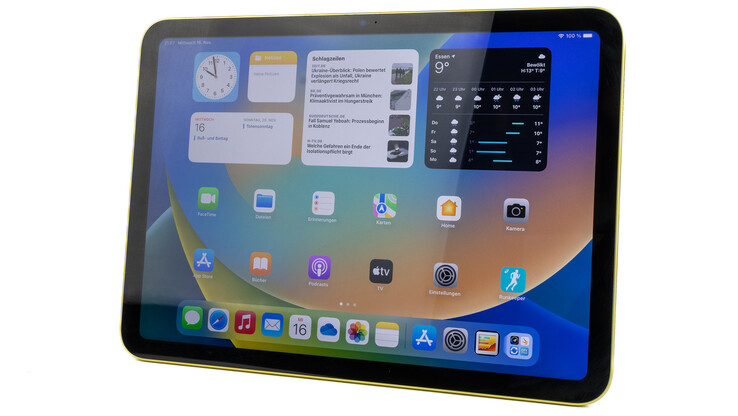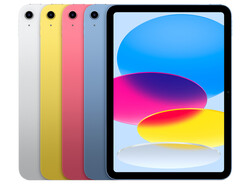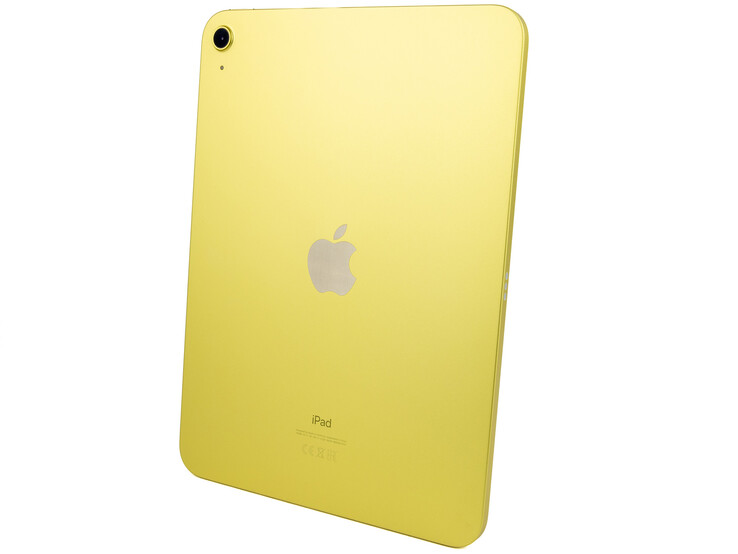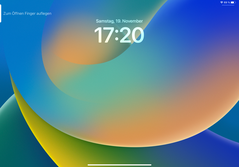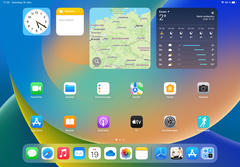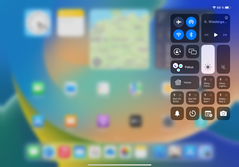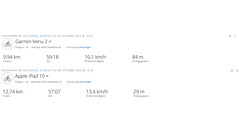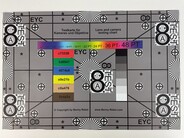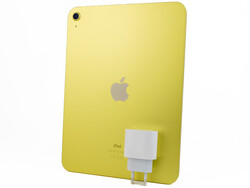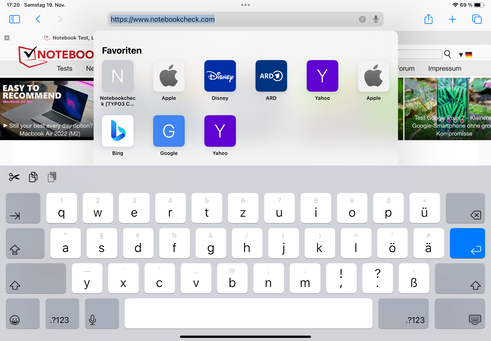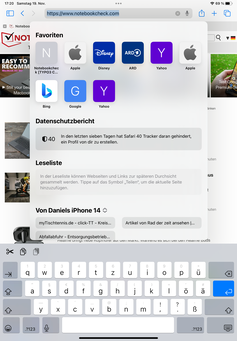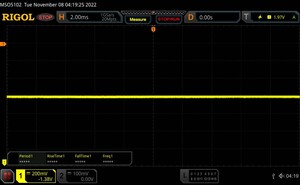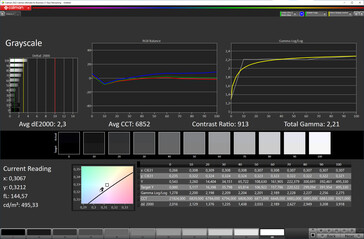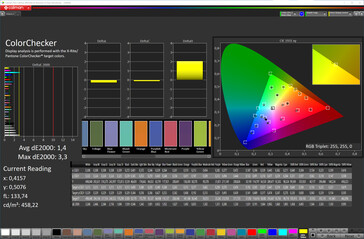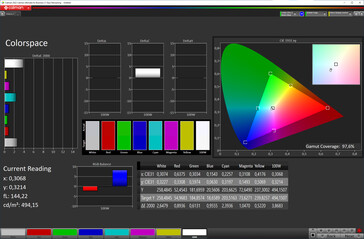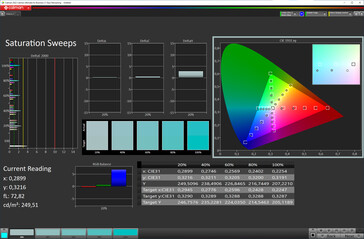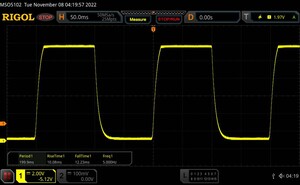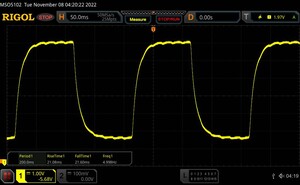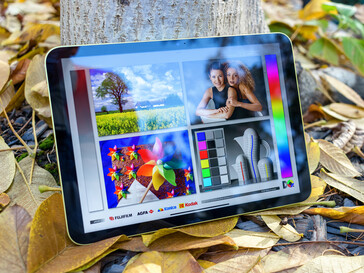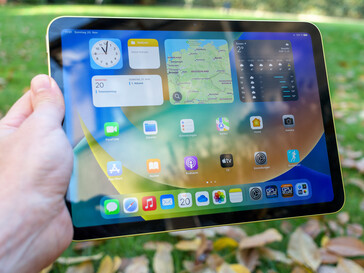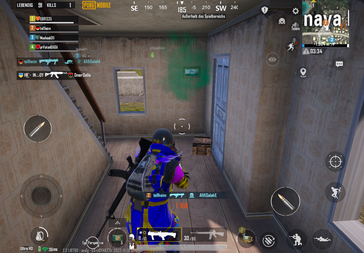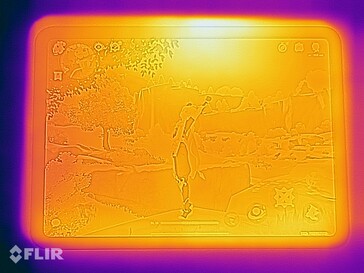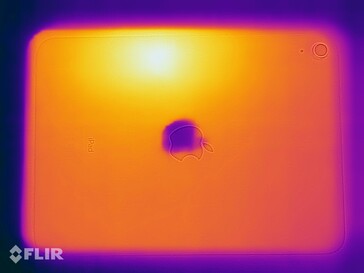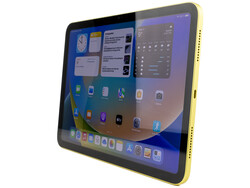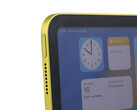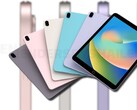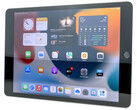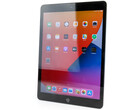Apple iPad 10 review - Anniversary tablet as slimmed down version of the iPad Air
At this point the Apple iPad of 2022 represents its 10th generation, celebrating its anniversary. For this occasion, Apple treats the most affordable iPad with a modern design and also increases the price by a hefty amount. Technically, it is a mix of the iPad 9 and iPad Air 4.
The Apple tablet is available in two storage versions. The smaller version offers 64 GB for 579 Euros (~$603) and the larger, 256 GB for 779 Euros (~$812). The optional mobile communication module costs an additional 200 Euros (~$208). Find out in this test, whether the most recent Apple tablet is worth its price, what differentiates it from the other models, and what the best alternatives are.
Possible Competitors in Comparison
Rating | Date | Model | Weight | Height | Size | Resolution | Price |
|---|---|---|---|---|---|---|---|
| 88.6 % v7 (old) | 11 / 2022 | Apple iPad 10 A14, A14 Bionic GPU | 477 g | 7 mm | 10.90" | 2360x1640 | |
| 91.7 % v7 (old) | 03 / 2022 | Apple iPad Air 5 2022 M1, M1 8-Core GPU | 461 g | 6.1 mm | 10.90" | 2360x1640 | |
| 88.5 % v7 (old) | 10 / 2021 | Apple iPad 2021 A13 Bionic, A13 Bionic GPU | 487 g | 7.5 mm | 10.20" | 2160x1620 | |
| 85.8 % v7 (old) | 08 / 2021 | Samsung Galaxy Tab S7 FE 5G SD 750G 5G, Adreno 619 | 608 g | 6.3 mm | 12.40" | 2560x1600 | |
| 88.7 % v7 (old) | 11 / 2021 | Xiaomi Pad 5 Pro SD 870, Adreno 650 | 515 g | 6.85 mm | 11.00" | 2560x1600 | |
| 89.2 % v7 (old) | 11 / 2022 | Lenovo Tab P11 Pro Gen 2 Kompanio 1300T, Mali-G77 MP9 | 480 g | 6.8 mm | 11.20" | 2560x1536 |
Case - Recycled aluminum in many colors
The Apple iPad 10 inherited the case design of the iPad Air, which was first introduced in 2020. The iPad 10 is available in silver, blue, rosé, and yellow color. The camera sticks out slightly from the aluminum unibody, so the tablet wobbles when you place it on a flat surface.
The quality of the workmanship is excellent. Due to the unibody design, there are hardly any gaps, and the material transitions are tight and even. The aluminum surface is prone to show fingerprints but very comfortable to hold. Compared to the current iPad Air, the iPad 10 is slightly larger in all dimensions, despite having the same-size panel.
The battery of the tablet is built in and cannot be replaced by the user. There is no certified protection against dust or water. Compared to the iPad 9, the efficiency was improved, the amount of plastic in the packaging was further reduced, and recycled gold and copper was used for the first time. In terms of sustainability, Apple publishes all the details in a detailed report.
Equipment - iPad 10 for the first time with USB-C
While the iPad 9 still included a Lightning port, the iPad 10 now offers USB-C. This makes sense, considering the EU regulation proscribing USB-C as the unified connection standard (we report), but the 1st generation of the Apple Pencil, which is compatible with the iPad, still uses the old connection. So those who want to recharge the pen directly from the tablet or still don't have a Lightning cable have to invest in an additional adapter for 10 Euros (~$10). With another corresponding adapter, the port can also be used for wired image output.
In terms of storage equipment, there is a version with 64 and a larger version with 256 GB. Those who require more storage have to use the cloud or can connect external data storage via the USB port.
The optional Magic Keyboard Folio can be connected via the Smart Connector. The Touch ID is in the power button.
Software - iPadOS 16.1 with a long period of updates
The Apple iPad 10 is delivered with iPadOS 16.1, which has already received a bug fix update to version 16.1.1 during our test. But in contrast to the Pro models, the new Stage Manager cannot be used here.
Except for its own services and apps, Apple doesn't install any other programs on the iPad. Usually, you can expect updates for around five years for the iPad, starting from the date of its introduction. However, there is no official announcement from Apple about this.
Communication and GNSS - Wi-Fi 6 and optional 5G for the iPad 2022
The Apple iPad 10 is able to connect to 2.4 and 5.0-GHz networks via dual-band WLAN. In combination with our Asus ROG Rapture GT-AXE11000 reference router, the transfer speeds turn out fairly constant and correspond to the advertised Wi-Fi 6 standard. The range is very good.
Optionally, you can also get a model with a 5G modem that can either be equipped with a Nano-SIM or eSIM. It supports a wide selection of frequency bands as well as GNSS.
| Networking | |
| iperf3 transmit AX12 | |
| Xiaomi Pad 5 Pro | |
| Apple iPad Air 5 2022 | |
| Samsung Galaxy Tab S7 FE 5G | |
| Apple iPad 2021 | |
| iperf3 receive AX12 | |
| Xiaomi Pad 5 Pro | |
| Apple iPad Air 5 2022 | |
| Samsung Galaxy Tab S7 FE 5G | |
| Apple iPad 2021 | |
| iperf3 receive AXE11000 | |
| Lenovo Tab P11 Pro Gen 2 | |
| Apple iPad Air 5 2022 | |
| Apple iPad 10 | |
| iperf3 transmit AXE11000 | |
| Apple iPad Air 5 2022 | |
| Lenovo Tab P11 Pro Gen 2 | |
| Apple iPad 10 | |
The WLAN model doesn't support locating its position via GNSS. Instead, the Apple tablet uses the WLAN, the digital compass, and iBeacon micro-locating to determine its own position. However, this is not sufficient for navigation tasks or recording routes.
Cameras - Good standard for the home office
The front camera of the Apple iPad (2022) uses a 12-MP ultra-wide angle lens and supports the Follow mode for video conferencing. With this, the camera automatically adjusts the image angle to keep one or more persons in the center of the image. With sufficient light, the recordings are fairly good. You can record videos in Full HD resolution at up to 60 frames per second.
The main camera on the back also offers a 12-MP resolution, but it can use Smart HDR 3 and an auto focus with Focus Pixels. In everyday photography, the recordings offer a good color reproduction with decent image capturing capabilities, but particular in terms of depth, they show some slight noise fairly early on. While this is definitely not a top performance, it is completely sufficient for documentation purposes.
The main camera is able to record videos in Ultra HD at up to 60 FPS.
Image comparison
Choose a scene and navigate within the first image. One click changes the position on touchscreens. One click on the zoomed-in image opens the original in a new window. The first image shows the scaled photograph of the test device.
HauptkameraHauptkamera5-fach ZoomLow-LightUnder controlled light conditions, our experiences from everyday photography are confirmed. The recording performance of the ColorChecker chart is relatively natural, only showing some slight DeltaE deviations without any coarse color inversions. Only dark green is brightened slightly too much.
The test chart shows good details in the center that reach all the way to the edge areas, although it is struggling with a slight loss in contrast there.
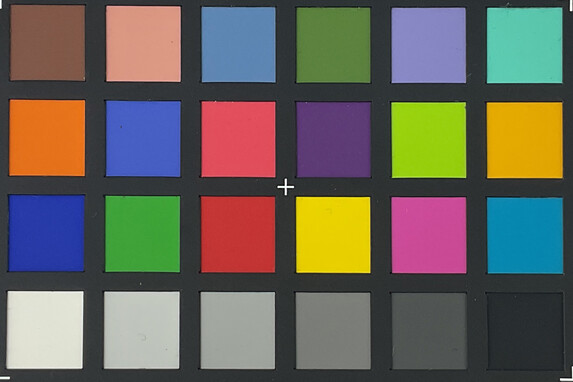

Accessories and Warranty - With the keyboard, it gets very expensive
The box of the 10th generation Apple iPad includes a USB-C cable and a modular 20-Watt charger.
The manufacturer warranty is only 12 months, but any vender warranty is not impacted by this. Optionally, you can also purchase Apple Care+ for the iPad, which lasts for two years at a cost of 79 Euros (~$82) or about 4 Euros (~$4) on a monthly basis. In addition to the expert support, you can get an unlimited amount of repairs during this time, as long as the damage was unintended. However, for each repair you also have to pay a universal service charge of 49 Euros (~$51) in the case of the iPad or 29 Euros (~$30) for the pen or keyboard.
Optionally, you can also purchase the Apple Pencil (Gen. 1 for 119 Euros, ~$124), Smart Folios in the corresponding case colors (for 99 Euros, ~$103 each) or the Magic Keyboard Folio (for 299 Euros, ~$312). Those who decide for the Pencil also have to purchase the corresponding USB adapter for this, in order to be able to connect the pen with the Apple tablet at all.
Input Devices and Operation - iPad 10 with Touch ID
The capacitive touchscreen of the Apple iPad 2022 responds to inputs quickly and reliably. As in the iPad 9, there is a slight distance between the panel and the front glass. So those who had hoped to get a fully laminated display will be disappointed. However, this doesn't impact the operation, and only those using the Pencil will have to get used to the feeling of the pen hovering slightly above the display contents.
The keyboard layout from Apple is installed as the onscreen keyboard, but you can also replace this by any other keyboard from the App Store. Optionally, you can also purchase an external keyboard. Unfortunately, we haven't been able to test this until now.
A fingerprint scanner (Touch ID) in the power key provides biometric security. Although this recognizes the stored fingerprints very reliably, it doesn't belong to the fastest of its kind.
Display - IPS panel with 60 Hz for the iPad 10.9
The size of the IPS display of the Apple iPad has increased to 10.9 inch (27.7 cm) in the diagonal, offering 2360 x 1640 pixels. While nominally, this corresponds to the panel in the iPad Air, it isn't laminated fully, doesn't cover the DCI-P3 color space, and also doesn't offer an antireflective layer.
The brightness of the LCD is supposed to reach 500 Nits. However, the iPad 10 doesn't quite reach this value in our measurements. With a full white display and activated brightness sensor, the tablet reaches 468 cd/m² on average. With an even distribution of light and dark areas (APL18), the brightness turns out only minimally higher, reaching 474 cd/m². Those who like to adjust the brightness manually will even get slightly more, since up to 492 cd/m² are then possible.
The black value is slightly elevated but still sufficient for a good contrast ratio. We do not notice any pulse-width modulation (PWM). As the slow-motion observation through a microscope shows, temporal dithering is also not used.
| |||||||||||||||||||||||||
Brightness Distribution: 92 %
Center on Battery: 467 cd/m²
Contrast: 953:1 (Black: 0.49 cd/m²)
ΔE ColorChecker Calman: 1.4 | ∀{0.5-29.43 Ø4.77}
ΔE Greyscale Calman: 2.3 | ∀{0.09-98 Ø5}
97.6% sRGB (Calman 2D)
Gamma: 2.21
CCT: 6852 K
| Apple iPad 10 IPS, 2360x1640, 10.9" | Apple iPad Air 5 2022 IPS, 2360x1640, 10.9" | Apple iPad 2021 IPS, 2160x1620, 10.2" | Samsung Galaxy Tab S7 FE 5G LCD IPS, 2560x1600, 12.4" | Xiaomi Pad 5 Pro IPS, 2560x1600, 11" | Lenovo Tab P11 Pro Gen 2 OLED, 2560x1536, 11.2" | |
|---|---|---|---|---|---|---|
| Screen | 16% | -3% | 6% | 6% | 1% | |
| Brightness middle (cd/m²) | 467 | 529 13% | 507 9% | 619 33% | 497 6% | 631 35% |
| Brightness (cd/m²) | 468 | 490 5% | 491 5% | 593 27% | 475 1% | 633 35% |
| Brightness Distribution (%) | 92 | 86 -7% | 90 -2% | 91 -1% | 89 -3% | 91 -1% |
| Black Level * (cd/m²) | 0.49 | 0.37 24% | 0.5 -2% | 0.22 55% | 0.42 14% | |
| Contrast (:1) | 953 | 1430 50% | 1014 6% | 2814 195% | 1183 24% | |
| Colorchecker dE 2000 * | 1.4 | 1.35 4% | 1.7 -21% | 2.6 -86% | 1.4 -0% | 1.7 -21% |
| Colorchecker dE 2000 max. * | 3.3 | 2.45 26% | 3.9 -18% | 6.6 -100% | 3 9% | 4.2 -27% |
| Greyscale dE 2000 * | 2.3 | 2.1 9% | 2.4 -4% | 4 -74% | 2.3 -0% | 2.6 -13% |
| Gamma | 2.21 100% | 2.183 101% | 2.25 98% | 2.17 101% | 2.25 98% | 2.23 99% |
| CCT | 6852 95% | 6939 94% | 6923 94% | 6973 93% | 6744 96% | 6496 100% |
* ... smaller is better
Screen Flickering / PWM (Pulse-Width Modulation)
| Screen flickering / PWM not detected | |||
In comparison: 53 % of all tested devices do not use PWM to dim the display. If PWM was detected, an average of 8080 (minimum: 5 - maximum: 343500) Hz was measured. | |||
The color analysis with the photo spectrometer and CalMAN software attests the Apple iPad 10.9 with a good display performance. We achieve the most natural results with the True Tone function deactivated, but we still notice a slightly warm white balance in bright gray tones even then. Almost all the deviations in the colors are not noticeable by the human eye alone. The only exception is cyan, but even that isn't even close to any distortion and not noticeable in everyday operation.
Display Response Times
| ↔ Response Time Black to White | ||
|---|---|---|
| 22.31 ms ... rise ↗ and fall ↘ combined | ↗ 10.08 ms rise | |
| ↘ 12.23 ms fall | ||
| The screen shows good response rates in our tests, but may be too slow for competitive gamers. In comparison, all tested devices range from 0.1 (minimum) to 240 (maximum) ms. » 49 % of all devices are better. This means that the measured response time is worse than the average of all tested devices (20.2 ms). | ||
| ↔ Response Time 50% Grey to 80% Grey | ||
| 42.68 ms ... rise ↗ and fall ↘ combined | ↗ 21.08 ms rise | |
| ↘ 21.6 ms fall | ||
| The screen shows slow response rates in our tests and will be unsatisfactory for gamers. In comparison, all tested devices range from 0.165 (minimum) to 636 (maximum) ms. » 70 % of all devices are better. This means that the measured response time is worse than the average of all tested devices (31.6 ms). | ||
Performance - Apple tablet with A14 SoC
The Apple iPad 10 uses the in-house A14 SoC, which was used for the first time in the iPad Air 2020. It has access to 4 GB of working memory.
The benchmarks show a mixed picture. While the results are slightly aboveaverage in Geekbench, the system benchmarks turn out minimally lower. However, in everyday operation you would not notice either one or the other, and the SoC runs with a high performance, ensuring smooth system operation.
| Geekbench ML | |
| 0.5 TensorFlow Lite CPU 0.5 | |
| Apple iPad Air 5 2022 | |
| Apple iPad 10 | |
| Average Apple A14 Bionic (n=1) | |
| Average of class Tablet (n=1last 2 years) | |
| 0.5 TensorFlow Lite GPU | |
| Apple iPad Air 5 2022 | |
| Apple iPad 10 | |
| Average Apple A14 Bionic (n=1) | |
| Average of class Tablet (n=1last 2 years) | |
| 0.5 TensorFlow Lite NNAPI / Core ML | |
| Apple iPad Air 5 2022 | |
| Apple iPad 10 | |
| Average Apple A14 Bionic (n=1) | |
| PassMark PerformanceTest Mobile V10 | |
| Storage Write | |
| Average of class Tablet (444 - 3540, n=5, last 2 years) | |
| Lenovo Tab P11 Pro Gen 2 | |
| Apple iPad 10 | |
| Average Apple A14 Bionic (n=1) | |
| Storage Read | |
| Average of class Tablet (879 - 1159, n=5, last 2 years) | |
| Apple iPad 10 | |
| Average Apple A14 Bionic (n=1) | |
| Lenovo Tab P11 Pro Gen 2 | |
The Apple A14 GPU integrated in the SoC handles the graphics computations, ensuring a very high performance and easily leaving the Android competitors behind. On the other hand, it is still surpassed by the iPad Air with the M1 processor.
GFXBench (DX / GLBenchmark) 2.7: T-Rex Onscreen | 1920x1080 T-Rex Offscreen
GFXBench 3.0: on screen Manhattan Onscreen OGL | 1920x1080 1080p Manhattan Offscreen
GFXBench 3.1: on screen Manhattan ES 3.1 Onscreen | 1920x1080 Manhattan ES 3.1 Offscreen
GFXBench: on screen Car Chase Onscreen | 1920x1080 Car Chase Offscreen | on screen Aztec Ruins High Tier Onscreen | 2560x1440 Aztec Ruins High Tier Offscreen | on screen Aztec Ruins Normal Tier Onscreen | 1920x1080 Aztec Ruins Normal Tier Offscreen
Basemark ES 3.1 / Metal: offscreen Overall Score
Basemark GPU 1.2: Vulkan Medium Native | 1920x1080 Vulkan Medium Offscreen | OpenGL Medium Native | 1920x1080 OpenGL Medium Offscreen | 1920x1080 Metal Medium Offscreen | Metal Medium Native
| 3DMark / Wild Life Extreme Unlimited | |
| Apple iPad Air 5 2022 | |
| Apple iPad 10 | |
| Apple iPad 2021 | |
| Xiaomi Pad 5 Pro | |
| Lenovo Tab P11 Pro Gen 2 | |
| Samsung Galaxy Tab S7 FE 5G | |
| 3DMark / Wild Life Extreme | |
| Apple iPad Air 5 2022 | |
| Apple iPad 10 | |
| Apple iPad 2021 | |
| Lenovo Tab P11 Pro Gen 2 | |
| Xiaomi Pad 5 Pro | |
| Samsung Galaxy Tab S7 FE 5G | |
| 3DMark / Wild Life Unlimited Score | |
| Apple iPad Air 5 2022 | |
| Apple iPad 10 | |
| Apple iPad 2021 | |
| Lenovo Tab P11 Pro Gen 2 | |
| Xiaomi Pad 5 Pro | |
| Samsung Galaxy Tab S7 FE 5G | |
| GFXBench (DX / GLBenchmark) 2.7 / T-Rex Onscreen | |
| Xiaomi Pad 5 Pro | |
| Lenovo Tab P11 Pro Gen 2 | |
| Apple iPad 2021 | |
| Apple iPad Air 5 2022 | |
| Apple iPad 10 | |
| Samsung Galaxy Tab S7 FE 5G | |
| GFXBench (DX / GLBenchmark) 2.7 / T-Rex Offscreen | |
| Apple iPad Air 5 2022 | |
| Apple iPad 10 | |
| Apple iPad 2021 | |
| Xiaomi Pad 5 Pro | |
| Lenovo Tab P11 Pro Gen 2 | |
| Samsung Galaxy Tab S7 FE 5G | |
| GFXBench 3.0 / Manhattan Onscreen OGL | |
| Xiaomi Pad 5 Pro | |
| Lenovo Tab P11 Pro Gen 2 | |
| Apple iPad 2021 | |
| Apple iPad Air 5 2022 | |
| Apple iPad 10 | |
| Samsung Galaxy Tab S7 FE 5G | |
| GFXBench 3.0 / 1080p Manhattan Offscreen | |
| Apple iPad Air 5 2022 | |
| Apple iPad 10 | |
| Apple iPad 2021 | |
| Xiaomi Pad 5 Pro | |
| Lenovo Tab P11 Pro Gen 2 | |
| Samsung Galaxy Tab S7 FE 5G | |
| GFXBench 3.1 / Manhattan ES 3.1 Onscreen | |
| Apple iPad Air 5 2022 | |
| Apple iPad 10 | |
| Apple iPad 2021 | |
| Xiaomi Pad 5 Pro | |
| Lenovo Tab P11 Pro Gen 2 | |
| Samsung Galaxy Tab S7 FE 5G | |
| GFXBench 3.1 / Manhattan ES 3.1 Offscreen | |
| Apple iPad Air 5 2022 | |
| Apple iPad 10 | |
| Apple iPad 2021 | |
| Xiaomi Pad 5 Pro | |
| Lenovo Tab P11 Pro Gen 2 | |
| Samsung Galaxy Tab S7 FE 5G | |
| GFXBench / Car Chase Onscreen | |
| Apple iPad Air 5 2022 | |
| Apple iPad 10 | |
| Apple iPad 2021 | |
| Xiaomi Pad 5 Pro | |
| Lenovo Tab P11 Pro Gen 2 | |
| Samsung Galaxy Tab S7 FE 5G | |
| GFXBench / Car Chase Offscreen | |
| Apple iPad Air 5 2022 | |
| Apple iPad 10 | |
| Apple iPad 2021 | |
| Xiaomi Pad 5 Pro | |
| Lenovo Tab P11 Pro Gen 2 | |
| Samsung Galaxy Tab S7 FE 5G | |
| GFXBench / Aztec Ruins High Tier Onscreen | |
| Apple iPad Air 5 2022 | |
| Apple iPad 2021 | |
| Apple iPad 10 | |
| Xiaomi Pad 5 Pro | |
| Lenovo Tab P11 Pro Gen 2 | |
| Samsung Galaxy Tab S7 FE 5G | |
| GFXBench / Aztec Ruins High Tier Offscreen | |
| Apple iPad Air 5 2022 | |
| Apple iPad 10 | |
| Apple iPad 2021 | |
| Xiaomi Pad 5 Pro | |
| Lenovo Tab P11 Pro Gen 2 | |
| Samsung Galaxy Tab S7 FE 5G | |
| GFXBench / Aztec Ruins Normal Tier Onscreen | |
| Apple iPad Air 5 2022 | |
| Apple iPad 2021 | |
| Apple iPad 10 | |
| Xiaomi Pad 5 Pro | |
| Lenovo Tab P11 Pro Gen 2 | |
| Samsung Galaxy Tab S7 FE 5G | |
| GFXBench / Aztec Ruins Normal Tier Offscreen | |
| Apple iPad Air 5 2022 | |
| Apple iPad 10 | |
| Apple iPad 2021 | |
| Xiaomi Pad 5 Pro | |
| Lenovo Tab P11 Pro Gen 2 | |
| Samsung Galaxy Tab S7 FE 5G | |
| Basemark ES 3.1 / Metal / Overall Score | |
| Apple iPad Air 5 2022 | |
| Apple iPad 10 | |
| Apple iPad 2021 | |
| Lenovo Tab P11 Pro Gen 2 | |
| Basemark GPU 1.2 / Vulkan Medium Native | |
| Lenovo Tab P11 Pro Gen 2 | |
| Basemark GPU 1.2 / Vulkan Medium Offscreen | |
| Lenovo Tab P11 Pro Gen 2 | |
| Basemark GPU 1.2 / OpenGL Medium Native | |
| Lenovo Tab P11 Pro Gen 2 | |
| Basemark GPU 1.2 / OpenGL Medium Offscreen | |
| Lenovo Tab P11 Pro Gen 2 | |
| Basemark GPU 1.2 / Metal Medium Offscreen | |
| Apple iPad 10 | |
| Apple iPad 2021 | |
| Basemark GPU 1.2 / Metal Medium Native | |
| Apple iPad 10 | |
| Apple iPad 2021 | |
Basemark GPUScore
Browsing the world wide web is fast with the iPad 10, which is also reflected in the benchmarks.
| Jetstream 2 - 2.0 Total Score | |
| Apple iPad Air 5 2022 (Safari 15) | |
| Apple iPad 10 (Safari Mobile 16.1) | |
| Average Apple A14 Bionic (158.2 - 178.9, n=6) | |
| Average of class Tablet (23.3 - 395, n=68, last 2 years) | |
| Apple iPad 2021 (Safari 15) | |
| Xiaomi Pad 5 Pro (Chrome 94.0.4606.85) | |
| Lenovo Tab P11 Pro Gen 2 (Chrome 107.0.5304.105) | |
| Samsung Galaxy Tab S7 FE 5G (Chrome91) | |
| WebXPRT 4 - Overall | |
| Apple iPad 10 (Safari Mobile 16.1) | |
| Average Apple A14 Bionic (n=1) | |
| Average of class Tablet (30 - 376, n=70, last 2 years) | |
| Lenovo Tab P11 Pro Gen 2 (Chrome 107.0.5304.105) | |
| WebXPRT 3 - Overall | |
| Apple iPad Air 5 2022 (Safari 15) | |
| Average of class Tablet (39 - 480, n=23, last 2 years) | |
| Apple iPad 10 (Safari Mobile 16.1) | |
| Apple iPad 2021 (Safari 15) | |
| Average Apple A14 Bionic (191 - 214, n=6) | |
| Xiaomi Pad 5 Pro (Chrome 94.0.4606.85) | |
| Samsung Galaxy Tab S7 FE 5G (Chrome91) | |
| Lenovo Tab P11 Pro Gen 2 (Chrome 107.0.5304.105) | |
| Speedometer 2.0 - Result 2.0 | |
| Apple iPad 10 (Safari Mobile 16.1) | |
| Apple iPad Air 5 2022 (Safari 15) | |
| Average of class Tablet (2.59 - 790, n=54, last 2 years) | |
| Average Apple A14 Bionic (188 - 272, n=6) | |
| Apple iPad 2021 (Safari 15) | |
| Xiaomi Pad 5 Pro (Chrome 94.0.4606.85) | |
| Lenovo Tab P11 Pro Gen 2 (Chrome 107.0.5304.105) | |
| Samsung Galaxy Tab S7 FE 5G (Chrome91) | |
| Octane V2 - Total Score | |
| Apple iPad Air 5 2022 (Safari 15) | |
| Apple iPad 10 (Safari Mobile 16.1) | |
| Average Apple A14 Bionic (55710 - 59963, n=6) | |
| Apple iPad 2021 (Safari 15) | |
| Average of class Tablet (763 - 138481, n=90, last 2 years) | |
| Xiaomi Pad 5 Pro (Chrome 94.0.4606.85) | |
| Lenovo Tab P11 Pro Gen 2 (Chrome 107.0.5304.105) | |
| Samsung Galaxy Tab S7 FE 5G (Chrome91) | |
| Mozilla Kraken 1.1 - Total | |
| Average of class Tablet (243 - 27101, n=79, last 2 years) | |
| Samsung Galaxy Tab S7 FE 5G (Chrome91) | |
| Lenovo Tab P11 Pro Gen 2 (Chrome 107.0.5304.105) | |
| Xiaomi Pad 5 Pro (Chrome 94.0.4606.85) | |
| Apple iPad 10 (Safari Mobile 16.1) | |
| Apple iPad 2021 (Safari 15) | |
| Apple iPad Air 5 2022 (Safari 15) | |
| Average Apple A14 Bionic (460 - 547, n=6) | |
* ... smaller is better
Gaming - A lot of power
Unfortunately, our partner GameBench doesn't support the current iPadOS at the time of this test yet, so that we are unable to present any results to you here.
However, the Apple A14 offers more than sufficient performance to display all the usual games at high detail settings, without having to limit the frame rates at all. Only in Genshin Impact, which is set to the highest quality levels at up to 60 FPS, we noticed the occasional small stutter.
Due to its weight, the tablet can become a bit heavy to hold in the hands in the long run, but it also offers a comfortably large display area and decent speakers.
Emissions - Only small losses in performance under load
Temperature
The Apple iPad 10 warms up noticeably already during idle operation, but this never becomes uncomfortable. Under load, some parts can even become significantly warmer. However, the temperatures always remain below the 37-ºC mark (99 ºF).
In the 3DMark stress test, the performance already drops slightly within the first 4 runs, although it remains stable afterwards. At around 14%, this performance drop turns out relatively small, and even then, the Apple tablet generates around 60% more frames per second than the Xiaomi Pad 5 Pro with the Snapdragon 870.
3DMark Wild Life Stress Test
(+) The maximum temperature on the upper side is 35.1 °C / 95 F, compared to the average of 33.6 °C / 92 F, ranging from 20.7 to 53.2 °C for the class Tablet.
(+) The bottom heats up to a maximum of 36.9 °C / 98 F, compared to the average of 33.2 °C / 92 F
(±) In idle usage, the average temperature for the upper side is 32 °C / 90 F, compared to the device average of 30 °C / 86 F.
Speakers
The Apple iPad 10 has two speakers on each short side, which produce a decent volume, although the high tones are slightly too present. In everyday operation, the offered performance is easily sufficient to listen to a bit of music or watch a movie at medium volume.
The USB-C port also allows you to connect wired headphones or speakers. For wireless listening, Bluetooth 5.2 is available, but the tablet only supports the SBC and AAC audio codecs.
Apple iPad 10 audio analysis
(+) | speakers can play relatively loud (84.6 dB)
Bass 100 - 315 Hz
(-) | nearly no bass - on average 18.2% lower than median
(±) | linearity of bass is average (10.5% delta to prev. frequency)
Mids 400 - 2000 Hz
(+) | balanced mids - only 3.9% away from median
(+) | mids are linear (4.8% delta to prev. frequency)
Highs 2 - 16 kHz
(±) | higher highs - on average 7.8% higher than median
(+) | highs are linear (5.3% delta to prev. frequency)
Overall 100 - 16.000 Hz
(±) | linearity of overall sound is average (18.3% difference to median)
Compared to same class
» 48% of all tested devices in this class were better, 6% similar, 46% worse
» The best had a delta of 7%, average was 20%, worst was 129%
Compared to all devices tested
» 39% of all tested devices were better, 8% similar, 53% worse
» The best had a delta of 4%, average was 24%, worst was 134%
Lenovo Tab P11 Pro Gen 2 audio analysis
(+) | speakers can play relatively loud (87.5 dB)
Bass 100 - 315 Hz
(-) | nearly no bass - on average 15% lower than median
(±) | linearity of bass is average (11.1% delta to prev. frequency)
Mids 400 - 2000 Hz
(±) | higher mids - on average 5.7% higher than median
(+) | mids are linear (5.9% delta to prev. frequency)
Highs 2 - 16 kHz
(+) | balanced highs - only 2.6% away from median
(+) | highs are linear (4.5% delta to prev. frequency)
Overall 100 - 16.000 Hz
(+) | overall sound is linear (13.6% difference to median)
Compared to same class
» 26% of all tested devices in this class were better, 4% similar, 70% worse
» The best had a delta of 7%, average was 20%, worst was 129%
Compared to all devices tested
» 14% of all tested devices were better, 4% similar, 82% worse
» The best had a delta of 4%, average was 24%, worst was 134%
Power Management - iPad 10 with a smaller battery
Power Consumption
The power consumption of the Apple iPad 10 during idle operation is slightly higher than that of the iPad 2021, but on the other hand, the newer model is more efficient under load. What is surprisingly high is the power consumption when it is in Standby mode.
The battery of the iPad 10 is smaller than that of last year's model. This might be due to the case design, since the iPad Air has a battery with a similar capacity. In our test, it takes around 2 hours and 45 minutes to completely recharge the battery.
| Off / Standby | |
| Idle | |
| Load |
|
Key:
min: | |
| Apple iPad 10 7606 mAh | Apple iPad Air 5 2022 mAh | Apple iPad 2021 8686 mAh | Samsung Galaxy Tab S7 FE 5G 10090 mAh | Xiaomi Pad 5 Pro 8600 mAh | Lenovo Tab P11 Pro Gen 2 8200 mAh | |
|---|---|---|---|---|---|---|
| Power Consumption | -11% | -2% | 14% | 23% | -0% | |
| Idle Minimum * (Watt) | 1.34 | 1.65 -23% | 1.3 3% | 1.06 21% | 1.14 15% | 3 -124% |
| Idle Average * (Watt) | 7.78 | 8.1 -4% | 7.5 4% | 6.25 20% | 4.3 45% | 4.21 46% |
| Idle Maximum * (Watt) | 7.89 | 9.4 -19% | 7.58 4% | 6.3 20% | 4.31 45% | 4.3 46% |
| Load Average * (Watt) | 9.05 | 9.5 -5% | 10.03 -11% | 8.76 3% | 8.09 11% | 6.8 25% |
| Load Maximum * (Watt) | 9.98 | 10.4 -4% | 10.91 -9% | 9.54 4% | 10.32 -3% | 9.5 5% |
* ... smaller is better
Power Consumption: Geekbench (150 cd/m²)
Power Consumption: GFXBench (150 cd/m²)
Battery Life
The battery life of the Apple tablet is at a good level, although it places last in our comparison. Our WLAN test measures realistic results and ensures comparable values due to the display brightness adjustment to 150 cd/m². At almost 11 hours, the iPad 10 lasts slightly longer than what Apple has specified, but all the competitors without exception have larger batteries, with most of them reaching a longer battery life. Only the Lenovo Tab P11 Pro is an exception in this regard.
| Apple iPad 10 7606 mAh | Apple iPad Air 5 2022 mAh | Apple iPad 2021 8686 mAh | Samsung Galaxy Tab S7 FE 5G 10090 mAh | Xiaomi Pad 5 Pro 8600 mAh | Lenovo Tab P11 Pro Gen 2 8200 mAh | |
|---|---|---|---|---|---|---|
| Battery runtime | 14% | 28% | 62% | 47% | 5% | |
| Reader / Idle (h) | 28.8 | 38.2 33% | 41.4 44% | 50.2 74% | 16.9 -41% | |
| H.264 (h) | 12.3 | 15 22% | 20.8 69% | 16.8 37% | 12.1 -2% | |
| WiFi v1.3 (h) | 10.8 | 10.8 0% | 13.4 24% | 17 57% | 15.4 43% | 9.4 -13% |
| Load (h) | 3.2 | 4.1 28% | 4.2 31% | 5.7 78% | 4.3 34% | 5.6 75% |
Pros
Cons
Verdict - Strong technology, but expensive
The introduction of the iPad 10 could have given a reason to rejoice, but unfortunately Apple put a damper on this with a hefty price increase compared to the predecessor. The largest progress of the iPad lies in the design, which now resembles that of the iPad Air.
Those who decide for the iPad 10 will get a fast tablet with an accurate display, good battery life, and optional 5G and will probably be very satisfied with it. However, the technological progress isn't as large as you might expect from the price increase.
The Apple iPad from 2022 demands a hefty price premium, but the technology is seamless.
The iPad continues to use a display that isn't fully laminated. While this is probably a plus in terms of repairability, it still feels a bit strange, particularly when using a pen and it appears to hover above the display. You also have to purchase an additional adapter for the pen to be able to connect it to the tablet at all. Although the display is flicker free, the brightness is at a similar level as that of the iPad 9 and the refresh rate is only 60 Hz.
Those who want to own an affordable iPad and don't mind the old design should still get last year's model. Particularly if you also need to purchase some Apple accessories, you can easily save several hundred Euros in this way, without any noticeable compromise. The battery life of that model is even better.
Other powerful alternatives are the Galaxy Tab S7 FE or the Lenovo Tab P11 Pro, which are not only more affordable but also include the corresponding input pen directly.
Price and Availability
Apple iPad 10
- 11/24/2022 v7 (old)
Daniel Schmidt


